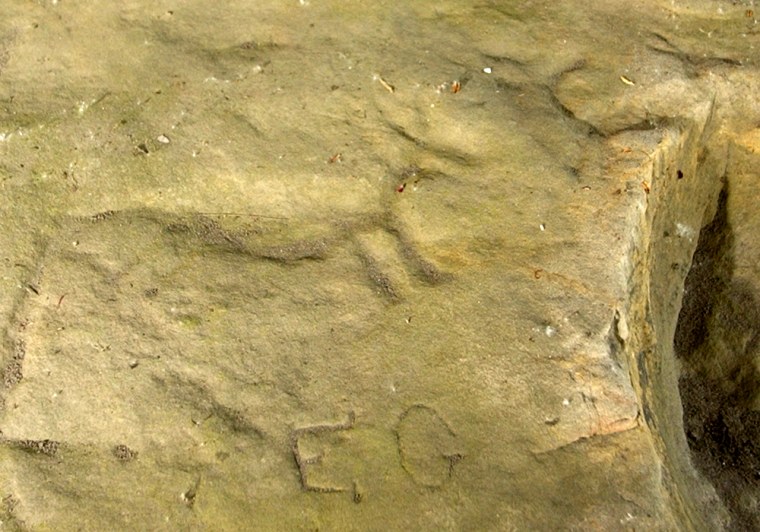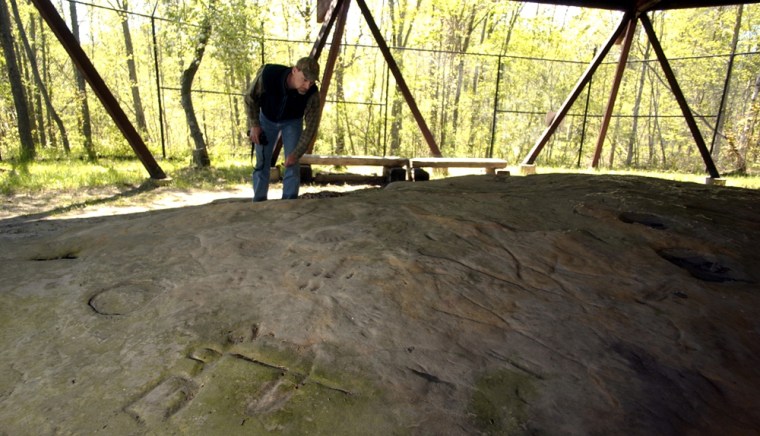The Sanilac Petroglyphs have drawn generations of visitors to a wooded area in rural Michigan, but the rare American Indian carvings are in danger of being lost forever unless something is done to preserve them.
The petroglyphs, the only known such carvings in Michigan and some of only a few in the Great Lakes region, were created anywhere from 400 to 1,000 years ago when Indians carved figures into a 25-by-40 square-foot piece of soft sandstone.
Farmers discovered them just before the turn of the 20th century, after massive fires of 1871 and 1881 cleared much of the heavy forests in Michigan’s Thumb area and burned away topsoil. Since then, the petroglyphs have suffered the wear and tear of harsh winters and the hundreds of visitors, who at times even carved their own initials in the stone.
Although the specific meaning of the swirls, lines, handprints, flying birds and bow-wielding men depicted in the carvings remains the subject of debate, experts say the petroglyphs, and their location, were significant to the Indians that traveled to the spot.
“These are very important figures religiously and mythologically. It’s not just random scratching or doodling. There was a purpose to going there,” said John Halsey, the state’s archaeologist.
Halsey explained that no one knows which Indian tribe created the petroglyphs or exactly when they did it, because a number of tribes moved through the area during that time, and artifacts that could be carbon-dated haven’t been found near the work.
“What I think it is, is a place where shamans or hunters went on vision quests and recorded what they saw,” Halsey said. “A lot of (the carvings) aren’t particularly representational of animals. There are some bird tracks, and some appear to be the great underwater panther, thunderbirds, things common to a great many native people across the Midwest.”
Now, after decades of seeing the carvings slowly disappear, local and state officials, along with one of Michigan’s most prominent Indian tribes, are forming a joint steering committee to find new ways to preserve the petroglyphs for future generations.
“It connects us back to the earth,” said Bonnie Ekdahl, director of the Saginaw Chippewa tribe’s Ziibiwing Center in Mount Pleasant. “It connects us back to the ancestors. We’re descended from those people. I mean where did we come from? We’ve always been here.”
The petroglyphs are located about 100 miles north of Detroit.

Petroglyphs aren’t uncommon in North America, but many are concentrated in the Southwest, where there is an abundance of the exposed rock that is rare in Michigan, Halsey said.
Other Great Lakes petroglyphs are less susceptible to environmental damage because they were carved in much harder materials. For example, the Jeffers Petroglyphs in Minnesota, which were carved in quartzite bedrock, are thought to be thousands of years older than the Sanilac Petroglyphs.
In addition to the effects of nature, the petroglyphs have been hurt by state budget cuts. Two years ago, Michigan officials cut the funding needed to keep the site open to the public, but a grant saved the area from being shuttered in 2004 and 2005. State officials are looking for funding to keep them open beyond this year.
Phillip Kwiatkowski, director of the Michigan Historical Museum System, said that preserving the stone, which is the only Indian site included in the state museum system, is a concern for state officials. He said the museum has been in discussions with the administrators of other petroglyphs in hopes of finding ways to preserve the carvings.
But others like Halsey are not as optimistic.
“It’s not going to disappear in 10 years, but do you know of anything that’s eternal?” Halsey asked. “What’s the annual swing of temperature there? One hundred degrees? The best way from a strictly archaeological standpoint is to document them and to otherwise minimize contact with the rock. And that’s very difficult to do.”
